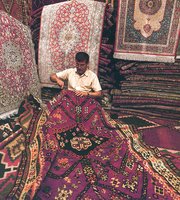Persian rug
|
|
| Contents |
Introduction

The Persian rug is an essential part of Persian art and culture. Thus carpet-weaving is undoubtedly one of the most distinguished manifestations of Persian (Iranian) culture and art, and dates back to the Bronze Age.
The earliest surviving corpus of Persian carpets come from the Safavid dynasty (1501-1736) in the 16th century. However, painted depictions prove a longer history of production. There is much variety among classical Persian carpets of the 16th and 17th century. Common motifs include scrolling vine networks, arabesques, palmettes, cloud bands, medallions, and overlapping geometric compartments. Some show figures engaged either in the hunt or feasting scenes. The majority of these carpets are wool, but several silk examples produced in Kashan survive.
History
With the passage of time, the materials used in carpets, including wool and cotton, decay. Therefore archaeologists are not able to make any particularly useful discoveries during archaeological excavations, save for special circumstances.
What has remained from early times as evidence of carpet-weaving is nothing more than a few pieces of worn-out rugs. And such fragments do not help very much in recognizing the carpet-weaving characteristics of pre-Seljuk period (13th and 14th centuries AD) in Persia.
Among the oldest pieces discovered are those found in Eastern Turkestan, dating back to the third to fifth centuries AD, and also some of the hand-weavings of the Seljuks of Asia Minor on exhibit in Ala?edin Mosque in Konya and Ashrafoghlu Mosque in Beyshehir, Turkey. These pieces attracted the attention of researchers earlier this century, and now they are kept in the Museum of Turkish and Islamic Art in Istanbul and the Mowlana Museum in Konya.
In a unique archaeological excavation in 1949 however, the exceptional Pazyryk carpet was discovered among the ices of Pazyryk Valley, in Altai Mountains in Siberia. It was discovered in the grave of a Scythian prince by a group of Russian archaeologists under the supervision of Sergei Ivanovich Rudenko. Radiocarbon testing revealed that Pazyryk carpet was woven in the 5th century BC. This carpet is 1.83ײ meters and has 36 symmetrical knots per cm². The advanced weaving technique used in the Pazyryk carpet indicates a long history of evolution and experience in this art. Most experts believe that the Pazyryk carpet is a late achievement of at least one thousand years of technique evolution and history.
According to this theory the art of carpet-weaving in Persia (Iran) is at least 3500 years old.
The Persian rug today
Although carpet production has mostly become mechanized today, the traditional hand woven rugs are still widely found, and usually have higher prices than the machine woven counterparts.
Many fine pieces of the Persian carpet are to be found in The Carpet Museum of Iran in Tehran.
Traditional Centers of carpet production in Iran
Farsh-Isfahan.jpg
The major classical centers of carpet production in Persia were in Tabriz (1500-1550), Kashan (1525-1650), Herat (1525-1650), and Kerman (1600-1650).
The majority of carpets from Tabriz have a central medallion and quartered corner medallions superimposed over a field of scrolling vine ornament, sometimes punctuated with mounted hunters, single animals, or animal combat scenes. Perhaps the most well-known of the Tabriz works are the two carpets perhaps made for the shrine at Ardabil (today in the collections of the Victoria and Albert Museum in London and the Los Angeles County Museum).
Kashan is known for its silk carpet production. Most famously, for the three silk hunting carpet masterpieces depicting mounted hunters and animal prey (currently in the collections of the Vienna Museum of Applied Arts (aka the MAK), the Museum of Fine Arts, Boston, and the Stockholm Museum). The Kashan rugs are among the most valuable in existence. One carpet, for example, is known to have been sold in Germany for $20,000 in 1969.
The Herat carpets, or ones of similar design created in Lahore and Agra, India, are the most numerous in Western collections. They are characterized by a red field with scrolling vine ornament and palmettes with dark green or blue borders.
The seven classes of Kerman carpet were defined by May Beattie. She identified their unique structure and named it the "vase technique." Carpet types in this group include garden carpets (ornamented with formal gardens and water channels) and the ogival lattice carpets. A fine and well-known example of the later was purchased by the Victoria and Albert Museum under the guidance of William Morris. The influence of Persian carpets is readily apparent in his carpet designs.
Carpet dealers have developed a classification for Persian carpets based on design, type of fabric, and weaving technique. The categories are named for cities and areas associated with each design:
- Maku
- Marand
- Tabriz (http://www.bukhara-carpets.com/making/persian_city_carpets_types.html#tabriz)
- Ahar
- Heris
- Meshkin Shahr
- Ardabil (http://www.bukhara-carpets.com/making/persian_city_carpets_types.html#ardabil)
- Saraband
- Sarab
- Mahabad
- Afshar
- Zanjan
- Bidjar (http://www.bukhara-carpets.com/making/persian_city_carpets_types.html#bidjar)
- Sanandaj
- Saraband
- Kermanshah
- Hariz
- Qazvin
- Hamedan
- Malayer
- Saroogh
- Farahan
- Qom
- Tehran
- Brujerd
- Arak
- Moshk Abad
- Mahalat
- Joshghan
- Kashan (http://www.bukhara-carpets.com/making/persian_city_carpets_types.html#kashan)
- Semnan
- Shahre Kord
- Isfahan
- Ardestan
- Naeen
- Shahr Reza
- Mamasani
- Abadeh
- Yazd
- Shiraz
- Rafsanjan
- Kerman
- Mahan
- Ravar
- Gorgan
- Gonbad Ghaboos
- Nishaboor
- Torghabeh
- Mashad
- Kashmar
- Gonabad
- Ferdos
- Ghayen
- Dorokhsh
- Birjand
- Mud
- Zabol
See also
- What is Persia?
- Iran's National Rug Gallery
- Persian Architecture
- Carpets of Isfahan
- Rugs and carpets in general
- Gelim (Also Kilim or Kelim)
